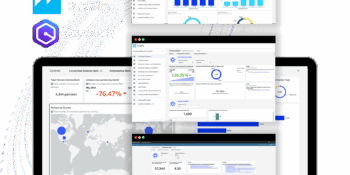Engineering Tradeshift’s AI-driven invoice coding engine: The evolution of Ada

By Daniel Urzica
Director of Engineering
Tradeshift
About the Author
As the Director of Engineering in Tradeshift Daniel acts as a bridge between the technical execution and business strategy, making sure that the engineering efforts drive successful business outcomes while maintaining a high technical standard.
How Tradeshift is revolutionizing AI-powered invoice coding for modern finance teams
Artificial Intelligence has become one of the most transformative forces in enterprise software, and for good reason. When applied thoughtfully, AI doesn’t just reduce friction. It rewires how we work. At Tradeshift, we’ve been pioneering AI in the e-invoicing space since 2017, and one of the earliest manifestations of that was our AI-powered invoice coding engine, Ada.
Ada has quietly powered automatic invoice coding for years, embedded in workflows across major enterprise finance teams. But we knew we could push the boundaries further. Today, we’re building a next-generation Ada, a major leap forward that doesn’t just improve accuracy but redefines the standard for intelligent AP automation.
Here’s the story behind that journey: from a simple statistical model to a sophisticated, adaptive AI engine built to handle the complexity of global enterprise invoicing.
👉 Check out AskAda for Sellers, our conversational AI-powered assistant that answers your questions in multiple languages in just a few seconds.
Ada 1.0: The first step in AI-powered invoice coding
When we launched our first AI-powered invoice coding engine, Ada, back in 2017, it was a breakthrough. It was a simple, fast engine powered by a Naive Bayes model that made predictions based on patterns in item descriptions, suppliers, and other key fields. Ada quietly powered automatic invoice coding for years, embedded in workflows across major enterprise finance teams.
But as our customers grew and their needs became more complex, we saw a clear path to make Ada even better. The challenges we faced were a natural part of our growth:
- The need for more depth: Our initial model worked well, but it assumed features were independent, which isn’t always true for complex invoice data.
- The demand for adaptability: As companies changed vendors and updated their coding lists, we needed a system that could learn and adapt more dynamically.
- Scaling for success: We needed an architecture that could handle thousands of account codes without a drop in performance, a challenge for our original model.
We saw these challenges not as limitations, but as a clear signal that it was time for a new chapter. We needed a smarter, more sophisticated foundation that could not only meet today’s needs but also anticipate tomorrow’s. This led us to the full architectural reboot that became Ada 2.0.
Engineering Ada 2.0: Building a smarter, scalable invoice automation engine
The second generation of Ada isn’t just a tune-up. It is a full architectural reboot, built from the ground up to be more accurate, adaptable, and scalable.
1. Moving from Naive Bayes to Decision Trees for smarter invoice coding
Ada 2.0 replaces the statistical simplicity of Naive Bayes with decision tree classifiers. This is a powerful machine learning technique that allows for better handling of interdependent features and hierarchical decision-making.
Each company using Tradeshift now has its own tailored model, trained on historical data from their invoices. And instead of a one-size-fits-all approach, we build a separate model per company and coding list pair.
What this means in practice:
- If your organization has 10 past invoices with similar line items, Ada can now detect patterns in those descriptions, currencies, tax schemes, and even supplier IDs to make highly relevant suggestions.
The more unique combinations you have in your past data, the better the predictions become.
2. Improving performance and adaptability in AI invoice processing
The new Ada was designed with both performance and adaptability in mind. Enterprises often change vendors, adjust tax logic, or roll out new cost centers. Ada 2.0 is built to keep up with those changes.
- Faster retraining pipelines allow us to re-learn from updated data more often.
- The new architecture handles larger label sets, such as thousands of account codes, without a drop in performance.
Less reliance on static rules means the system is more resilient when business logic evolves.
3. Expanding AI document support for invoices and credit notes
While Ada originally focused on invoice lines, version 2.0 now supports:
- NPO and PO invoices with varying levels of PO line references.
- Credit notes, even when the referenced invoice is missing.
- Dynamic fallback mechanisms for scenarios where only partial coding is available.
All of this plugs directly into our workflow engine, ensuring that Ada can automatically suggest codes at the right step in the invoice lifecycle. In most cases, this happens before your team even opens the document.
👉 Discover the five lessons we learned from migrating a legacy analytics tool to an embedded new app powered by Amazon QuickSight and Amazon Q
Architecture behind Ada 2.0: How AI powers Tradeshift’s invoice coding engine
Ada 2.0 is not a standalone system. It is part of a broader architecture designed to deliver fast, accurate, and transparent invoice processing for enterprise users.
Here’s a high-level view of how it works:
- The workflow engine orchestrates the document lifecycle, triggering Ada coding at just the right moment.
- apps-workflow-elements exposes Ada functions for use as workflow steps.
- ada-coding is the backend service that receives predictions, validates them, and applies business logic.
- ada-rules adds an extra layer of control, checking XML documents for compliance and conditional logic.
- universal-suggestions houses our model infrastructure and smart prediction engine.
- coding-entry-service applies final codes to documents.
- iceberg helps maintain metrics, accuracy thresholds, and performance tuning.
This modular setup allows Ada to be fast, flexible, and fault-tolerant. These are critical qualities in any enterprise-grade AP automation system.
Real Impact: What AI invoice coding means for finance teams
For finance managers, our new AI-powered invoice coding engine represents a shift in how your teams work and what they can achieve:
- Higher accuracy: Fewer incorrect predictions mean fewer manual corrections. Ada 2.0 significantly reduces the time spent reviewing and adjusting invoice lines.
- Faster invoice processing: With smarter auto-coding, your approvals move faster, exceptions drop, and payment cycles become shorter.
- Better compliance: Structured, predictable coding suggestions help reinforce internal controls and audit-readiness.
Scalability: Whether you’re processing 1,000 invoices a month or 100,000, Ada 2.0 scales to meet your needs. It adapts to your data, your structure, and your language.
What’s next for AI in accounts payable automation
Ada 2.0 is scheduled for launch in our Fall Release. Over time, we’ll expand support for AllowanceCharge lines, improve training flows, and add explainability features to help finance teams understand why a particular prediction was made.
The future of invoice automation is not manual review or static rule sets. It is AI-powered, adaptive, and engineered for enterprise scale. With Ada, that future is already here.
Get in touch with a Tradeshift representative if you want to embed AI into your AP workflows.
You may also be interested in
AI that makes AP (and everything else) smarter
Meet Ada, our next-level artificial intelligence and machine learning layer that’s embedded on the Tradeshift platform. Ada assists users by responding to information requests and by providing contextual suggestions at the point-of-task across the platform and beyond.
Inside the journey: How we brought AI-powered analytics to Tradeshift users
Our legacy analytics tool, Insight Center, had its quirks. It restricted scheduled reports to 25MB, and required manual work to keep data pipelines healthy. But it was familiar, and familiarity breeds trust. So when we introduced the new Reporting & Analytics app with embedded dashboards and reports built in Amazon QuickSight, even with better performance and design, users were quick to point out differences in numbers. This wasn’t a bug—it was a trust gap.
From OCR to Autonomous Finance: Building an AI-Native AP Platform
When it comes to AI, we’re way past the theoretical. I remember just a few years ago, in 2021, when we were discussing with businesses about Autonomous AI on the Tradeshift platform, it felt like something out of a distant future. The market just wasn’t ready for it. As a forward-thinking company, our clients often share our mindset. We had some trailblazers who decided to use Ada, our AI coding layer for AP automation, trusting her with up to 99.5% of their processes, even in those early days.
AI-powered insights: The new Reporting & Analytics App at a glance
Artificial intelligence is rapidly transforming how finance teams operate. From accounts payable to procurement to supplier collaboration, business leaders are turning to AI to simplify complex processes and improve decision-making across the board. At Tradeshift, we’ve been on this journey since 2017, steadily embedding AI into the fabric of our platform to support a more autonomous, efficient, and data-driven future. This year we’ve taken another step forward with the Reporting & Analytics app: a smart, embedded analytics solution that brings AI-powered reporting directly to users across our global business network.



